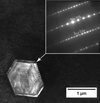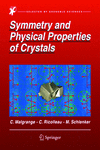issue contents
May 2017 issue

Cover illustration: Trinodal, edge-2-transitive polyhedra and 2-periodic tilings are of special interest for the design and synthesis of materials such as metal-organic polyhedra and frameworks [Delgado-Friedrichs and O'Keeffe (2017). Acta Cryst. A73, 227-230]. The augmented (truncated) form mty-a of the icosahedral polyhedron mty is shown.
research papers
The crystal structures of M7C3, M5C2, M3C and M23C6 carbides are determined by the finite projective geometry constructions, namely the Desargues configuration 103 and its subconfigurations. The unique mechanism of the liquid-crystal transition and in situ polymorph transformations between these carbides is described within the framework of the same approach.
The phantom derivative phasing method has been generalized via the study of joint probability distribution functions involving the prior knowledge of a model electron-density map or of a molecular model structure.
All trinodal, edge-2-transitive polyhedra and 2-periodic tilings are described.
It is shown that chemical short-range order in two-component molecular crystals can be solved directly by separating the influence of the molecular form factor.
Groupoids and labelled quotient graphs: a topological analysis of the modular structure in pyroxenes
A signature of partial symmetry operations acting in orthoenstatite is evidenced in its labelled quotient graph.
Open  access
access
 access
accessA uniform geometric/algebraic approach to the Penrose and Taylor–Socolar hexagonal tilings is given, which clarifies their construction and the way in which they are inter-related.
The energy dependence of resonant magnetic scattering factors revealed antiparallel magnetic moments within the t2 (3d) orbitals at the Fe K pre-edge. Circular polarization of X-rays is a powerful tool for examining magnetic electrons via both resonant and non-resonant magnetic scatterings simultaneously.
short communications
The combinatorial types of convex n-acra with minimum and maximum names for any n ≥ 4 are found. Thus, the latter can be directly calculated from the adjacency matrices of their edge graphs.
book reviews
Free 

Free 

Free 



 journal menu
journal menu






























